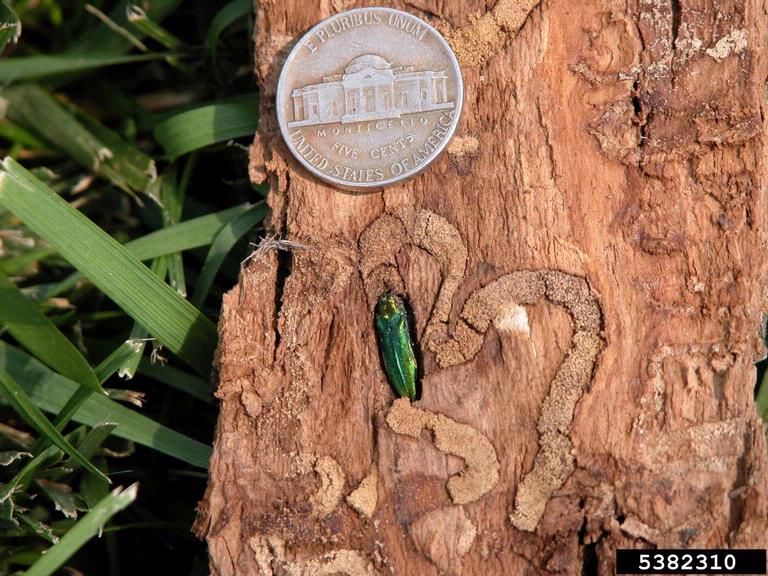The emerald ash borer, a tiny yet destructive invasive beetle known for wiping out ash trees on a large scale, has been confirmed at six new locations in northwest Oregon.
First discovered in Forest Grove in 2022, the beetle showed up at traps in Multnomah, Washington, Yamhill and Clackamas counties this summer.
The beetle was previously found in northern Marion County and Salem officials have taken preemptive measures to slow it from killing city trees.
Just a half inch in length and with a distinctive green color, the invader from northeastern Asia has killed millions of ash trees and wiped out entire forests by laying larvae in the trees’ tissue under the bark.
An emerald ash borer next to a nickel for size comparison.
“The pattern of spread in the eastern U.S. has been that populations at first increase slowly and the rate of natural spread is slow,” said Cody Holthouse, manager of the Oregon Department of Agriculture’s Insect Pest Prevention and Management Program. “But within a few years there is a rapid build-up in the population and it spreads in all directions at a faster pace. That’s exactly what we’re starting to see with these detections.”
Quarantine zones seek to slow spread
Five of the sites where the beetle was found this summer were all in quarantine zones where borers were previously found.
Quarantine zones are established to stop people from moving borers by limiting the movement of ash, white fringe and olive tree materials for uses like firewood.
A map showing the quarantine zones can be found at tinyurl.com/bdesmrmu

This map shows where emerald ash borders have been confirmed and their quarantine zones where moving hardwood — where firewood from hardwood trees cannot be removed to stop humans from spreading borers around.
“At that point, further spread is almost entirely by humans moving firewood,” said Oregon Department of Forestry invasive species specialist Wyatt Williams. “That’s why it’s recommended you buy or cut firewood within 10 miles of where you plan to burn it.”
Where were emerald ash borders found in Oregon this summer?
Ash borders were found at traps in six locations this summer.
“Finding one in a trap usually means there are quite a few already in that area,” Holthouse said.
The six sites were all in the northern Willamette Valley area including:
-
The parking lot of the David Douglas Aquatics Center in the Hazelwood-Mill Park area in Multnomah County.
-
Hazeldale Park about a mile west of Beaverton
-
Killin Wetlands Nature Park near Banks in western Washington County
-
5 miles northwest of the town of Yamhill in Yamhill County
-
3 miles southeast of Oregon City in Clackamas County
-
Bureau of Land Management-administered land east of Scotts Mills in Clackamas County
For the past few summers, ODF has made sticky purple traps available to numerous public land managers and soil and water conservation districts that agreed to place and monitor the traps.
“Traps contain a lure and are checked periodically during the summer when adult EAB are flying. It was in those traps that the beetles were found,” Williams said.

An adult emerald ash borer caught in a sticky trap in Marion County.
What Salem and Keizer are doing to combat the problem
Arborists in Salem have been treating high-value public ash trees to protect them ahead of EAB’s arrival, a news release said.
Treatment includes injecting insecticide at the base of the trunk so it gets taken up into the tree canopy and “is quite effective at protecting the tree from both adults and larvae,” said Matt Mills, EAB specialist with ODF.
Keizer is inventorying its street trees to find how many are ash, officials said.
Portland, along with other metro area cities, is taking a variety of actions including treatment of public trees in good condition and the pre-emptive removal of ash trees in poor condition.
What people can do to slow emerald ash borers
Officials first asked people who believe they’ve seen an emerald ash border by comparing them to pictures at OregonEAB.com
People who believe they’ve found EAB should report it over the phone to 1-866-INVADER or online at oregoninvasiveshotline.org/reports/create
“If you can capture the beetle in a jar or other container that’s ideal, but at least try and take a clear, close-up photo. This helps us identify the insect in question much more easily,” said ODF specialist Kat Bethea.
What does emerald ash borer infestation look like?
Any ash tree can be infested, including native Oregon ash as well as non-native street, park and yard trees.
Signs of infestation include thinning and yellowing leaves, bark splitting, D-shaped holes in the tree bark, and shoots from buds on the trunk or branches, said Bethea.

Galleries created by the larvae of emerald ash borer are seen under the bark of an Oregon ash tree in Marion County.
Protecting trees with insecticide
People who want to protect their ash trees before they become infested can consider the same treatment as Salem by injecting insecticide.
Mills said treatments ideally should be done before trees are damaged, and repeated every two or three years by a licensed pesticide applicator.
“That’s why we recommend only treating high-value trees in good condition,” he said. “Ash trees planted in the wrong place to reach their mature size, such as under powerlines, should be removed as time and funds permit and replaced with species that aren’t susceptible to EAB.”
Starting over with different trees
Officials also said landowners should consider “replacing young ash trees while they are still small and starting over by planting a species that is not susceptible to EAB,” a news release said.
“This gets new tree canopy jump-started in urban areas where ash trees will be lost if not treated,” Mills said.
Zach Urness has been an outdoors reporter in Oregon for 18 years and is host of the Explore Oregon Podcast. He can be reached at zurness@StatesmanJournal.com or (503) 399-6801. Find him on X at @ZachsORoutdoors and BlueSky at oregonoutdoors.bsky.social
This article originally appeared on Salem Statesman Journal: Deadly emerald ash borer found at 6 new sites in Oregon: What to know









